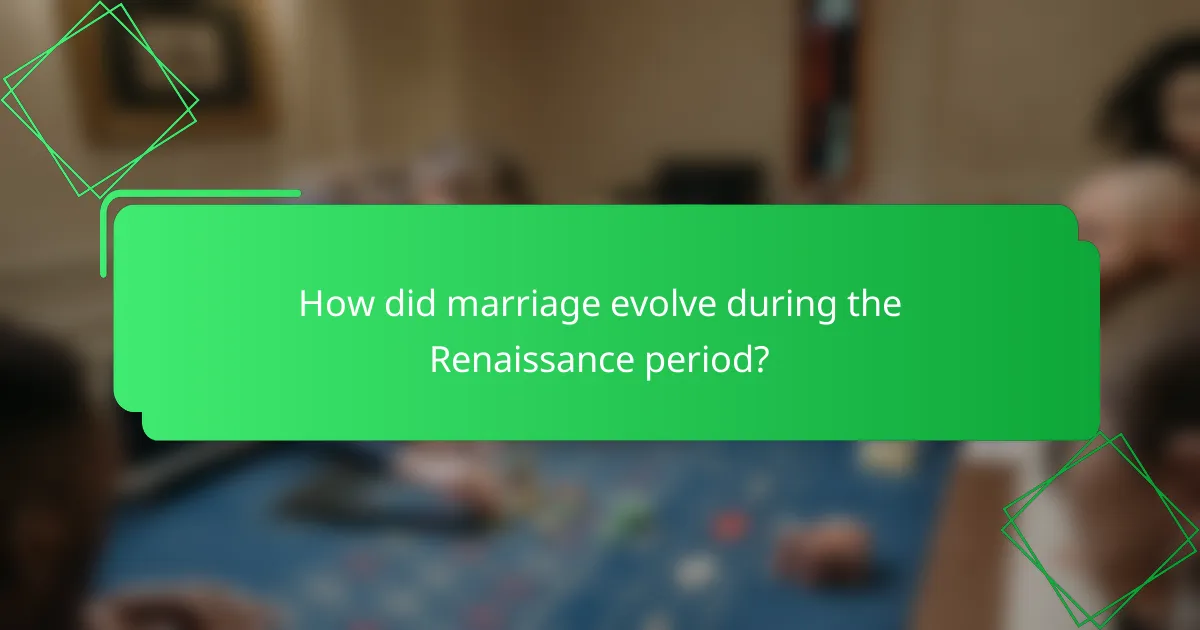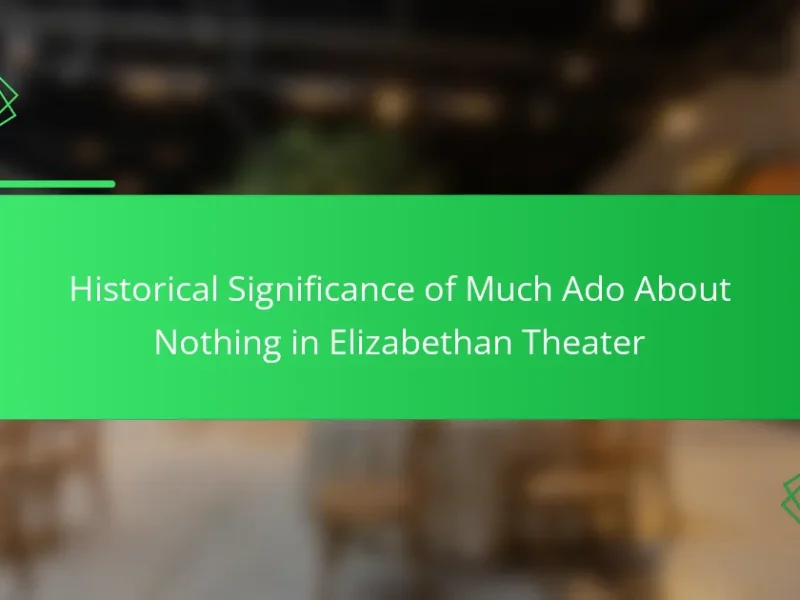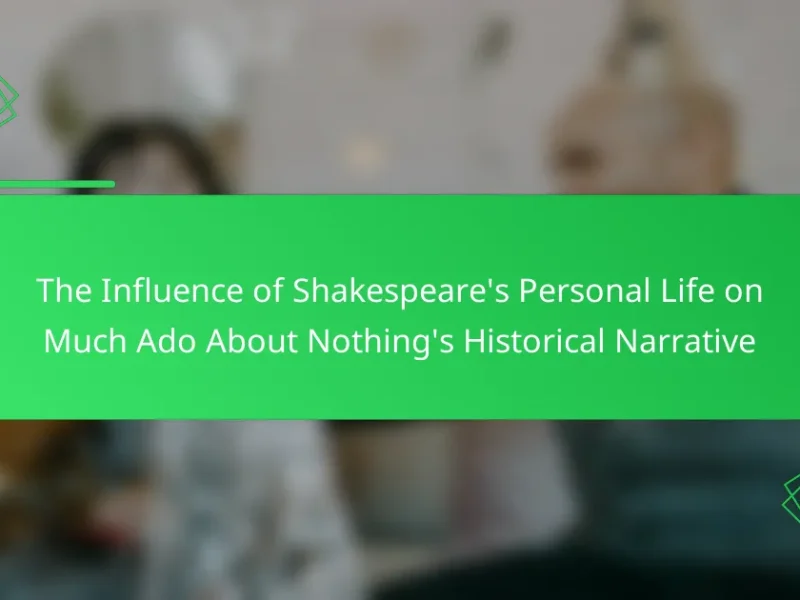
What are the themes of Much Ado About Nothing?
The themes of Much Ado About Nothing include love, deception, honor, and social expectations. Love is portrayed in various forms, such as romantic love and friendship. Deception plays a crucial role, often leading to misunderstandings and comedic situations. Honor is significant, especially regarding reputation and societal pressures. Social expectations shape characters’ actions and relationships throughout the play. These themes reflect the complexities of human relationships during the Renaissance. They highlight the evolving perception of marriage in that era.
How does Much Ado About Nothing reflect the societal views on marriage during the Renaissance?
Much Ado About Nothing reflects societal views on marriage during the Renaissance by highlighting the importance of honor and reputation. The play illustrates how marriages were often viewed as social contracts rather than romantic unions. Characters like Claudio and Hero demonstrate the expectation of fidelity and the consequences of perceived dishonor. Claudio’s public shaming of Hero at their wedding underscores the societal pressure surrounding female virtue. Additionally, the witty banter between Beatrice and Benedick challenges traditional gender roles in marriage. Their relationship suggests that mutual respect and companionship can coexist with societal expectations. Overall, the play captures the tension between personal desires and societal norms regarding marriage during the Renaissance.
What are the key attributes of marriage depicted in Much Ado About Nothing?
Key attributes of marriage depicted in Much Ado About Nothing include love, deception, and social status. Love is portrayed as essential for a successful marriage, particularly between Beatrice and Benedick. Their witty banter highlights the importance of mutual respect and affection. Deception plays a significant role, as seen in the plot to bring Beatrice and Benedick together. This manipulation shows how external influences can shape relationships. Social status is also critical, as characters like Claudio and Hero navigate societal expectations. Their union reflects the era’s emphasis on honor and reputation. These attributes collectively illustrate the complexities of marriage during the Renaissance.
How do the characters in the play embody the changing perceptions of marriage?
The characters in “Much Ado About Nothing” reflect the evolving views of marriage during the Renaissance. For instance, Beatrice challenges traditional gender roles by expressing her independence and skepticism towards marriage. Her witty dialogue and refusal to conform highlight a shift in women’s expectations. Conversely, Hero represents the conventional ideals of femininity and obedience. Her character illustrates the societal pressures women faced to uphold marital expectations. Claudio’s impulsive decisions demonstrate the male perspective on honor and reputation tied to marriage. The contrast between Beatrice and Hero embodies the tension between traditional and progressive views of marriage. This dynamic showcases the broader societal debate about love, loyalty, and gender roles during the period.
What role does deception play in the portrayal of marriage in Much Ado About Nothing?
Deception plays a crucial role in the portrayal of marriage in Much Ado About Nothing. The play utilizes deception to create misunderstandings and ultimately facilitate romantic unions. For instance, the scheme to fake Hero’s death serves to test Claudio’s love and loyalty. This deception leads to a deeper understanding of love and commitment among the characters. Additionally, Benedick and Beatrice’s relationship evolves through a series of deceptions orchestrated by their friends. These deceptions reveal their true feelings and lead to their eventual marriage. The use of deception highlights the complexities of love and trust within relationships, reflecting Renaissance views on marriage. Ultimately, deception acts as a catalyst for character development and the resolution of conflicts in the pursuit of marital happiness.
How does the use of deception affect the relationships between characters?
Deception significantly impacts relationships between characters in “Much Ado About Nothing.” It creates misunderstandings and conflicts, altering perceptions of trust. For instance, Claudio’s belief in Hero’s infidelity leads to public shaming, damaging their relationship. Similarly, Benedick and Beatrice’s initial deception about their feelings creates tension but ultimately fosters a deeper connection. These instances illustrate how deception can both harm and enhance relationships, reflecting the complexities of love and trust during the Renaissance.
What does the resolution of deception reveal about marriage in the Renaissance?
The resolution of deception in “Much Ado About Nothing” highlights the complexities of trust and fidelity in Renaissance marriage. Deception is used to challenge and ultimately reaffirm romantic relationships. The characters’ journeys reveal societal expectations surrounding honor and reputation. For instance, Hero’s public shaming and subsequent vindication illustrate the fragility of a woman’s status in marriage. Additionally, the reconciliation between Beatrice and Benedick shows the negotiation of power dynamics in relationships. Their banter reflects evolving views on love and partnership during the Renaissance. The resolution underscores the importance of communication and understanding in marital bonds. Overall, the play reveals that deception can both threaten and strengthen marriage, reflecting the era’s changing perceptions.

How did marriage evolve during the Renaissance period?
Marriage during the Renaissance period evolved significantly from earlier traditions. It transitioned from being primarily a social contract for economic and political alliances to a more personal and romantic union. The rise of humanism emphasized individual choice and love in marriage. Literature and art began to celebrate romantic love as a legitimate basis for marriage. This shift is evident in works like Shakespeare’s “Much Ado About Nothing,” which reflects changing attitudes. During this time, the role of women in marriage also began to change, as they gained more agency in choosing their partners. The Protestant Reformation further influenced marriage practices by challenging the Catholic [censured]’s authority over marital matters. This period laid the groundwork for modern concepts of marriage based on love and partnership.
What were the traditional views on marriage before the Renaissance?
Traditional views on marriage before the Renaissance emphasized social and economic alliances. Marriages were often arranged by families to strengthen ties and secure wealth. Love was not considered a necessary component of marriage. Instead, the focus was on duty, obedience, and familial obligation. Women were typically viewed as property exchanged between families. Consent from the bride was often overlooked in favor of parental approval. Additionally, marriage served as a means to ensure legitimate heirs. These views were prevalent across various cultures during this period.
How did economic factors influence marriage customs during this time?
Economic factors significantly influenced marriage customs during the Renaissance. Wealth and social status dictated marriage arrangements. Families often sought advantageous unions to enhance their economic standing. Dowries became essential, as they provided financial security and demonstrated family wealth. Marriages were frequently arranged rather than based on love. This practice solidified alliances between families and improved social capital. Economic stability was crucial for sustaining households. Thus, financial considerations shaped the expectations and norms surrounding marriage during this period.
What role did religion play in shaping marriage perceptions in the Renaissance?
Religion significantly influenced marriage perceptions during the Renaissance. The Catholic [censured] viewed marriage as a sacred sacrament. This belief elevated the importance of marital unions in society. Religious doctrines dictated the roles of husbands and wives. For instance, men were seen as the heads of the household. Women were expected to be submissive and nurturing. Additionally, the [censured] emphasized the necessity of consent in marriage. Marriages were often arranged, yet the [censured]’s teachings encouraged mutual consent. This duality shaped societal expectations surrounding love and partnership. Overall, religion provided a framework that defined the institution of marriage during this period.
What were the emerging attitudes toward love and marriage in the Renaissance?
Emerging attitudes toward love and marriage in the Renaissance shifted towards individual choice and romantic love. This period saw a decline in arranged marriages, emphasizing personal preference. Literature and art reflected these changing views, portraying love as a noble pursuit. The rise of humanism encouraged individuals to seek emotional connections. Notable works, such as Shakespeare’s plays, illustrated these ideals. For instance, “Much Ado About Nothing” highlighted the tension between societal expectations and personal desires in relationships. Marriage began to be seen as a partnership based on mutual affection rather than mere economic necessity. This transformation marked a significant cultural shift in attitudes towards love and marriage during the Renaissance.
How did literature and art influence the perception of romantic love in marriage?
Literature and art significantly shaped the perception of romantic love in marriage during the Renaissance. Works like Shakespeare’s “Much Ado About Nothing” emphasized love as a central theme in marriage. This portrayal encouraged the idea that marriages could be based on affection and emotional connection rather than solely on social or economic considerations.
Art from the period often depicted idealized romantic relationships, reinforcing the notion that love should be a fundamental aspect of marriage. For instance, paintings and poetry celebrated the beauty of love, influencing societal expectations. The romantic ideals presented in literature and art contributed to a cultural shift, where personal happiness became more valued in marital unions.
The rise of the sonnet and romantic poetry further popularized the concept of love as essential to marriage. These artistic expressions highlighted the emotional and passionate dimensions of relationships, contrasting with earlier views that prioritized duty and arrangement. Overall, literature and art played a crucial role in evolving the perception of romantic love within the institution of marriage during the Renaissance.
What shifts occurred in the roles of men and women within marriage during this period?
During the Renaissance, significant shifts occurred in the roles of men and women within marriage. Men increasingly assumed roles as breadwinners and decision-makers. Women began to gain more agency and were encouraged to express their opinions. The concept of romantic love started to take precedence over arranged marriages. This change allowed for more emotional connections between spouses. Additionally, women’s education began to improve, leading to greater involvement in intellectual discussions. Legal rights for women also saw gradual enhancements, allowing for more independence. These shifts reflected broader societal changes regarding gender roles and expectations in marriage.

What insights can we gain from Much Ado About Nothing regarding modern marriage?
Much Ado About Nothing provides insights into the complexities of modern marriage. The play explores themes of trust, communication, and societal expectations. Characters like Beatrice and Benedick challenge traditional views on marriage. Their witty banter reflects the importance of mutual respect and understanding. The misunderstandings in the play highlight the need for open dialogue. Additionally, the role of deception illustrates how trust can be easily undermined. The resolution of conflicts emphasizes the value of forgiveness in relationships. Overall, the play suggests that modern marriage requires both individuality and partnership.
How can the lessons from Much Ado About Nothing apply to contemporary views on marriage?
Lessons from Much Ado About Nothing emphasize the importance of communication and trust in marriage. The play illustrates how misunderstandings can lead to conflict, as seen with Claudio and Hero. This reflects contemporary views that prioritize open dialogue between partners. Additionally, the theme of love versus societal expectations resonates today. Characters like Beatrice and Benedick challenge traditional roles, mirroring modern discussions on equality in marriage. The resolution of conflicts through understanding and forgiveness in the play supports the idea that healthy relationships require effort and compromise. These lessons remain relevant in contemporary discussions about the dynamics of marriage.
What parallels can be drawn between the play’s themes and current societal norms surrounding marriage?
The play “Much Ado About Nothing” explores themes of love, trust, and societal expectations surrounding marriage. These themes resonate with current societal norms that emphasize the importance of mutual respect and communication in relationships. In the play, misunderstandings and deception challenge the integrity of relationships, mirroring contemporary issues such as trust and fidelity in modern marriages. Additionally, the play highlights the tension between individual desires and societal pressures, reflecting ongoing discussions about personal choice versus tradition in marriage today. The characters’ journeys towards understanding and acceptance parallel the evolving views on partnership and equality in modern relationships.
What practical advice can be taken from Much Ado About Nothing for modern relationships?
Much Ado About Nothing offers practical advice for modern relationships by emphasizing the importance of communication and trust. Characters often misinterpret intentions due to lack of clear dialogue. For instance, the misunderstandings between Beatrice and Benedick highlight how assumptions can lead to conflict. Additionally, the resolution of these conflicts demonstrates that honesty can restore relationships. The play also illustrates the value of friendship in romantic partnerships. The supportive bond between characters like Hero and Beatrice showcases the strength of female friendship in navigating love. Lastly, the themes of forgiveness and reconciliation are crucial for maintaining healthy relationships. The characters’ journeys reflect the necessity of overcoming pride and embracing vulnerability.
How can communication and honesty improve modern marriages as depicted in the play?
Communication and honesty can significantly improve modern marriages as depicted in “Much Ado About Nothing.” The play illustrates that open dialogue fosters trust between partners. Honest conversations allow couples to resolve misunderstandings effectively. For instance, the characters Benedick and Beatrice demonstrate how clear communication strengthens their relationship. Their witty exchanges reveal their true feelings, leading to a deeper connection. Additionally, the resolution of conflicts through honest discussions showcases the importance of transparency. This reflects a modern understanding that communication is vital for marital stability. Overall, the play emphasizes that honesty and effective communication are essential for nurturing love and trust in marriage.
What strategies can couples learn from the characters’ experiences in Much Ado About Nothing?
Couples can learn several strategies from the characters’ experiences in Much Ado About Nothing. First, communication is crucial. For instance, misunderstandings between characters lead to conflict. Secondly, trust is essential in relationships. Claudio’s doubts about Hero demonstrate the damage of mistrust. Thirdly, the importance of honesty is highlighted. Beatrice and Benedick’s candid discussions strengthen their bond. Additionally, forgiveness plays a vital role. Hero’s eventual reconciliation with Claudio shows the power of forgiveness in mending relationships. Lastly, humor can help navigate challenges. The witty banter between Beatrice and Benedick illustrates how humor can ease tension. These strategies reflect the complexities of love and marriage during the Renaissance.
Much Ado About Nothing serves as a critical examination of the evolving perception of marriage during the Renaissance. The article explores key themes such as love, deception, honor, and social expectations, highlighting how these elements shape characters’ actions and relationships. It discusses the societal views on marriage, emphasizing the transition from social contracts to romantic unions, and the impact of deception on trust and fidelity. Additionally, the article draws parallels between the play’s themes and contemporary views on marriage, offering practical advice for modern relationships based on communication, trust, and mutual respect.


